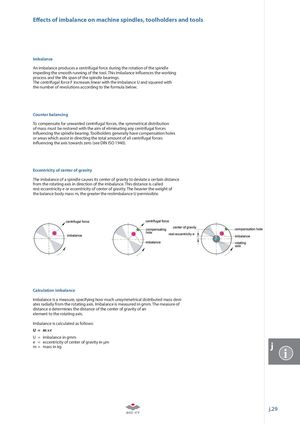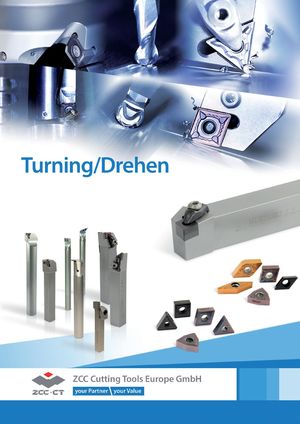Каталог ZCC-CT оснастка - страница 378
Навигация

E ects of imbalance on machine spindles, toolholders and tools Imbalance An imbalance produces a centrifugal force during the rotation of the spindle impeding the smooth running of the tool. This imbalance in uences the working process and the life span of the spindle bearings. The centrifugal force F increases linear with the imbalance U and squared with the number of revolutions according to the formula below. Counter balancing To compensate for unwanted centrifugal forces, the symmetrical distribution of mass must be restored with the aim of eliminating any centrifugal forces in uencing the spindle bearing. Toolholders generally have compensation holes or areas which assist in directing the total amount of all centrifugal forces in uencing the axis towards zero (see DIN ISO 1940). Eccentricity of center of gravity The imbalance of a spindle causes its center of gravity to deviate a certain distance from the rotating axis in direction of the imbalance. This distance is called rest-eccentricity e or eccentricity of center of gravity. The heavier the weight of the balance body mass m, the greater the restimbalance U permissible. Calculation imbalance Imbalance is a measure, specifying how much unsymmetrical distributed mass devi- ates radially from the rotating axis. Imbalance is measured in gmm. The measure of distance e determines the distance of the center of gravity of an element to the rotating axis. Imbalance is calculated as follows: U = m×r U = imbalance in gmm e = eccentricity of center of gravity in μmm=mass in kg j i j.29
 Каталог ZCC-CT токарная обработка
Каталог ZCC-CT токарная обработка Каталог ZCC-CT сверла монолитные
Каталог ZCC-CT сверла монолитные Каталог ZCC-CT расточные системы
Каталог ZCC-CT расточные системы Каталог ZCC-CT фрезы монолитные
Каталог ZCC-CT фрезы монолитные Каталог ZCC-CT фрезы со сменными пластинами
Каталог ZCC-CT фрезы со сменными пластинами